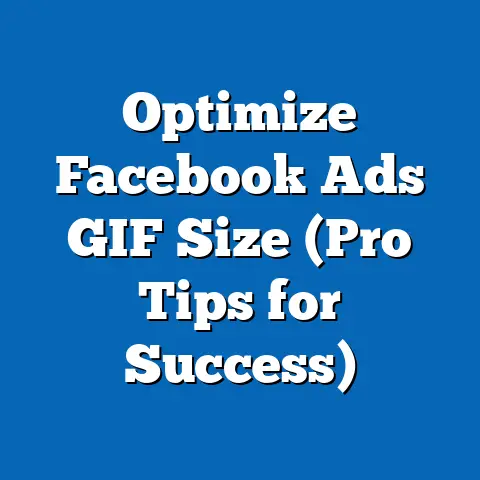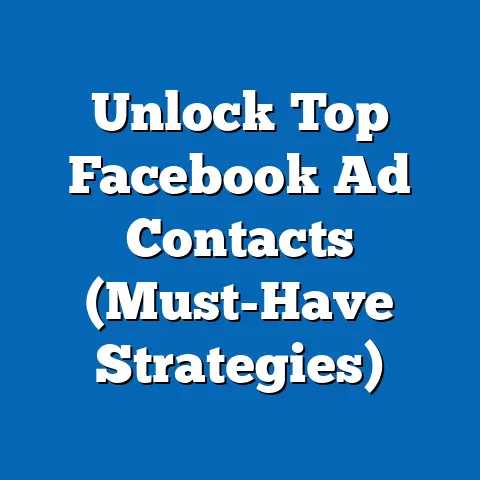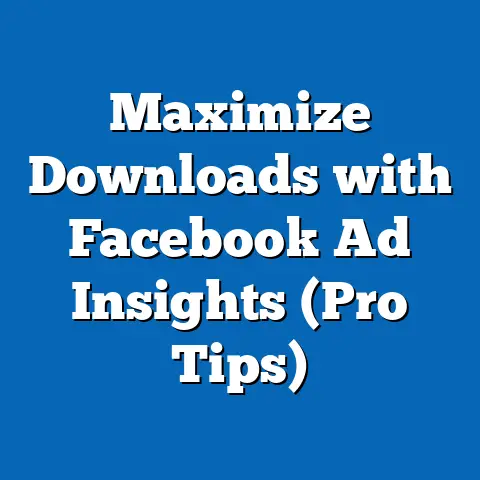Unlocking Facebook Political Ads for 2025 (Strategic Insights)
As we approach the 2025 elections, the battleground of democracy extends beyond the ballot box and into the digital realm—where Facebook is the new Coliseum for political gladiators. This isn’t just about running a few ads; it’s about strategically navigating a complex landscape to shape narratives, influence voters, and ultimately, win elections. I’ve seen firsthand how a well-crafted Facebook political ad campaign can make or break a candidate. It’s a world where data, creativity, and ethics collide, and understanding the nuances is crucial for success.
Unlocking Facebook Political Ads for 2025: Strategic Insights
Political advertising on Facebook has come a long way since its inception. Initially, it was a simple extension of traditional campaign tactics, but it has evolved into a sophisticated ecosystem where algorithms, data analytics, and targeted messaging reign supreme. From Obama’s groundbreaking use of social media in 2008 to the controversies surrounding the 2016 election, Facebook has played a pivotal role in shaping political narratives.
Think about it: political advertising is no longer just a campaign tool. It’s a crucial element of democratic engagement and information dissemination. It’s where candidates connect with voters, share their platforms, and respond to the issues of the day. But with great power comes great responsibility, and the ethical considerations surrounding political ads on Facebook are more critical than ever.
The Current Landscape of Facebook Political Ads
As of 2023, the state of political advertising on Facebook is dynamic and ever-changing. Ad spending continues to rise, with major players in the political arena investing heavily in the platform. According to Statista, political ad spending on social media in the U.S. is projected to reach nearly $2 billion by 2024. This demonstrates the sheer scale of investment political campaigns are willing to make to reach voters on Facebook.
The types of ads dominating the platform include:
- Issue-based ads: These ads focus on specific policy issues, often targeting voters based on their interests and concerns.
- Candidate-focused ads: These ads highlight the candidate’s qualifications, experience, and vision for the future.
- Attack ads: These ads criticize opposing candidates, often using negative messaging to sway voters.
- Get-out-the-vote ads: These ads encourage people to register and vote, often targeting specific demographics.
However, recent changes in Facebook’s advertising policies, particularly in light of misinformation and data privacy concerns, have significantly affected political campaigns. Facebook has implemented stricter verification processes, labeling requirements, and content moderation policies to combat the spread of false information. For instance, ads related to social issues, elections, or politics must now include a “Paid for by” disclaimer, providing transparency about who is funding the ad.
These changes have forced political campaigns to adapt their strategies, focusing on more transparent and authentic messaging. I’ve noticed that campaigns are now more cautious about the claims they make in their ads, knowing that they will be subject to greater scrutiny.
Takeaway: Understanding the current landscape of Facebook political ads is crucial for any campaign looking to succeed in 2025. Stay informed about policy changes, monitor ad spending trends, and adapt your strategies accordingly.
Key Strategies for Success in 2025
To maximize their effectiveness on Facebook, political campaigns need to leverage proven strategies that resonate with voters. Here are some key tactics:
-
Audience Targeting Techniques:
- Demographic Targeting: This involves targeting voters based on age, gender, location, education, and other demographic factors. For example, a campaign might target young voters with ads about student loan debt relief.
- Psychographic Insights: This involves targeting voters based on their values, attitudes, interests, and lifestyles. Understanding the psychographics of your target audience can help you craft more persuasive messages. I once worked on a campaign where we used psychographic data to identify voters who were passionate about environmental issues. We then created ads highlighting the candidate’s commitment to clean energy, which resonated strongly with this segment.
- Interest-Based Segmentation: This involves targeting voters based on their interests and hobbies, as indicated by their Facebook activity. For example, a campaign might target voters interested in outdoor activities with ads about protecting public lands.
-
Creative Messaging:
-
Authenticity: Voters are increasingly skeptical of political ads, so it’s important to be authentic and genuine in your messaging. Share personal stories, highlight the candidate’s values, and avoid overly polished or scripted content.
- Emotional Appeal: Effective political ads often tap into voters’ emotions, such as hope, fear, or anger. Use storytelling techniques to connect with voters on an emotional level. For example, a campaign might share a story about a family struggling to make ends meet, highlighting the candidate’s commitment to economic opportunity.
- Clarity: Keep your message clear and concise. Voters are bombarded with information, so it’s important to cut through the noise and get your point across quickly. Use strong visuals and compelling headlines to grab attention.
-
Timing and Frequency:
-
Optimal Timing: The best time to launch ads depends on your target audience and campaign goals. For example, you might launch ads closer to the election to maximize their impact, or you might start earlier to build awareness and generate excitement.
- Frequency: Serving ads too frequently can lead to ad fatigue, where voters become annoyed and tune out your message. On the other hand, serving ads too infrequently can mean that your message gets lost in the shuffle. I recommend testing different frequencies to find the optimal balance for your campaign.
Audience Targeting Techniques:
- Demographic Targeting: This involves targeting voters based on age, gender, location, education, and other demographic factors. For example, a campaign might target young voters with ads about student loan debt relief.
- Psychographic Insights: This involves targeting voters based on their values, attitudes, interests, and lifestyles. Understanding the psychographics of your target audience can help you craft more persuasive messages. I once worked on a campaign where we used psychographic data to identify voters who were passionate about environmental issues. We then created ads highlighting the candidate’s commitment to clean energy, which resonated strongly with this segment.
- Interest-Based Segmentation: This involves targeting voters based on their interests and hobbies, as indicated by their Facebook activity. For example, a campaign might target voters interested in outdoor activities with ads about protecting public lands.
-
Creative Messaging:
-
Authenticity: Voters are increasingly skeptical of political ads, so it’s important to be authentic and genuine in your messaging. Share personal stories, highlight the candidate’s values, and avoid overly polished or scripted content.
- Emotional Appeal: Effective political ads often tap into voters’ emotions, such as hope, fear, or anger. Use storytelling techniques to connect with voters on an emotional level. For example, a campaign might share a story about a family struggling to make ends meet, highlighting the candidate’s commitment to economic opportunity.
- Clarity: Keep your message clear and concise. Voters are bombarded with information, so it’s important to cut through the noise and get your point across quickly. Use strong visuals and compelling headlines to grab attention.
-
Timing and Frequency:
-
Optimal Timing: The best time to launch ads depends on your target audience and campaign goals. For example, you might launch ads closer to the election to maximize their impact, or you might start earlier to build awareness and generate excitement.
- Frequency: Serving ads too frequently can lead to ad fatigue, where voters become annoyed and tune out your message. On the other hand, serving ads too infrequently can mean that your message gets lost in the shuffle. I recommend testing different frequencies to find the optimal balance for your campaign.
Creative Messaging:
Authenticity: Voters are increasingly skeptical of political ads, so it’s important to be authentic and genuine in your messaging. Share personal stories, highlight the candidate’s values, and avoid overly polished or scripted content.
Timing and Frequency:
Optimal Timing: The best time to launch ads depends on your target audience and campaign goals. For example, you might launch ads closer to the election to maximize their impact, or you might start earlier to build awareness and generate excitement.
Takeaway: Success in Facebook political advertising requires a deep understanding of your audience, compelling creative messaging, and strategic timing. Experiment with different targeting techniques, messaging styles, and ad schedules to find what works best for your campaign.
The Role of Data Analytics
Data analytics can significantly enhance the effectiveness of political ads by providing insights into voter behavior, ad performance, and campaign ROI.
-
Tools and Metrics:
- Facebook Ads Manager: This is the primary tool for creating and managing Facebook ads. It provides a wealth of data on ad performance, including impressions, reach, clicks, and conversions.
- Google Analytics: By integrating Google Analytics with your Facebook ads, you can track how users interact with your website after clicking on your ads. This can help you measure the effectiveness of your ads in driving traffic, generating leads, and boosting sales.
- A/B Testing: This involves creating multiple versions of your ads and testing them against each other to see which performs best. You can test different headlines, images, ad copy, and call-to-action buttons to optimize your ads for maximum impact.
-
Case Studies:
-
Obama’s 2012 Campaign: Obama’s campaign used data analytics extensively to target voters with personalized messages. They identified key voter segments and crafted ads tailored to their specific interests and concerns. This allowed them to mobilize volunteers, raise money, and ultimately win the election.
- Trump’s 2016 Campaign: Trump’s campaign used data analytics to identify and target swing voters in key states. They used emotionally charged messaging to appeal to voters’ fears and anxieties, which proved to be highly effective.
Tools and Metrics:
- Facebook Ads Manager: This is the primary tool for creating and managing Facebook ads. It provides a wealth of data on ad performance, including impressions, reach, clicks, and conversions.
- Google Analytics: By integrating Google Analytics with your Facebook ads, you can track how users interact with your website after clicking on your ads. This can help you measure the effectiveness of your ads in driving traffic, generating leads, and boosting sales.
- A/B Testing: This involves creating multiple versions of your ads and testing them against each other to see which performs best. You can test different headlines, images, ad copy, and call-to-action buttons to optimize your ads for maximum impact.
-
Case Studies:
-
Obama’s 2012 Campaign: Obama’s campaign used data analytics extensively to target voters with personalized messages. They identified key voter segments and crafted ads tailored to their specific interests and concerns. This allowed them to mobilize volunteers, raise money, and ultimately win the election.
- Trump’s 2016 Campaign: Trump’s campaign used data analytics to identify and target swing voters in key states. They used emotionally charged messaging to appeal to voters’ fears and anxieties, which proved to be highly effective.
Case Studies:
Obama’s 2012 Campaign: Obama’s campaign used data analytics extensively to target voters with personalized messages. They identified key voter segments and crafted ads tailored to their specific interests and concerns. This allowed them to mobilize volunteers, raise money, and ultimately win the election.
However, data analytics is not without its challenges. It’s important to use data ethically and responsibly, respecting voters’ privacy and avoiding manipulative or deceptive tactics.
Takeaway: Data analytics is a powerful tool for optimizing Facebook political ads, but it’s important to use it ethically and responsibly. Focus on understanding your audience, measuring ad performance, and refining your strategies based on data-driven insights.
Navigating Ethical Considerations
Political advertising on Facebook raises a number of ethical dilemmas, particularly concerning the balance between persuasive messaging and misinformation.
-
Persuasive Messaging vs. Misinformation:
- Transparency: It’s important to be transparent about who is funding your ads and what your campaign’s goals are. Avoid using deceptive or misleading tactics to trick voters.
- Accuracy: Ensure that the information you share in your ads is accurate and fact-checked. Avoid spreading false rumors or conspiracy theories.
- Respect: Treat opposing candidates and voters with respect. Avoid using personal attacks or inflammatory language.
-
Algorithm-Driven Content Delivery:
-
Filter Bubbles: Algorithms can create filter bubbles, where voters are only exposed to information that confirms their existing beliefs. This can lead to polarization and division.
- Echo Chambers: Algorithms can also create echo chambers, where voters are surrounded by like-minded individuals who reinforce their views. This can make it difficult for voters to engage in constructive dialogue with people who hold different opinions.
Persuasive Messaging vs. Misinformation:
- Transparency: It’s important to be transparent about who is funding your ads and what your campaign’s goals are. Avoid using deceptive or misleading tactics to trick voters.
- Accuracy: Ensure that the information you share in your ads is accurate and fact-checked. Avoid spreading false rumors or conspiracy theories.
- Respect: Treat opposing candidates and voters with respect. Avoid using personal attacks or inflammatory language.
-
Algorithm-Driven Content Delivery:
-
Filter Bubbles: Algorithms can create filter bubbles, where voters are only exposed to information that confirms their existing beliefs. This can lead to polarization and division.
- Echo Chambers: Algorithms can also create echo chambers, where voters are surrounded by like-minded individuals who reinforce their views. This can make it difficult for voters to engage in constructive dialogue with people who hold different opinions.
Algorithm-Driven Content Delivery:
Filter Bubbles: Algorithms can create filter bubbles, where voters are only exposed to information that confirms their existing beliefs. This can lead to polarization and division.
Platforms like Facebook have a responsibility to curb harmful content and promote a healthy democratic discourse. They should invest in fact-checking resources, implement stricter content moderation policies, and promote media literacy among users.
Takeaway: Ethical considerations are paramount in Facebook political advertising. Strive for transparency, accuracy, and respect in your messaging, and be mindful of the potential impact of algorithms on political discourse.
Preparing for Future Trends
The landscape of Facebook political ads is constantly evolving, and it’s important to prepare for future trends.
-
Technological Advancements:
- AI-Driven Ads: Artificial intelligence can be used to create highly personalized ads that are tailored to individual voters’ interests and needs.
- Augmented Reality: Augmented reality can be used to create immersive experiences that engage voters in new and exciting ways.
- Virtual Reality: Virtual reality can be used to create virtual town halls and campaign rallies that allow voters to interact with candidates in a more personal way.
-
Regulatory Changes:
-
Data Privacy Laws: New data privacy laws, such as the California Consumer Privacy Act (CCPA), could restrict the amount of data that campaigns can collect and use to target voters.
- Campaign Finance Laws: New campaign finance laws could limit the amount of money that campaigns can spend on Facebook ads.
Technological Advancements:
- AI-Driven Ads: Artificial intelligence can be used to create highly personalized ads that are tailored to individual voters’ interests and needs.
- Augmented Reality: Augmented reality can be used to create immersive experiences that engage voters in new and exciting ways.
- Virtual Reality: Virtual reality can be used to create virtual town halls and campaign rallies that allow voters to interact with candidates in a more personal way.
-
Regulatory Changes:
-
Data Privacy Laws: New data privacy laws, such as the California Consumer Privacy Act (CCPA), could restrict the amount of data that campaigns can collect and use to target voters.
- Campaign Finance Laws: New campaign finance laws could limit the amount of money that campaigns can spend on Facebook ads.
Regulatory Changes:
Data Privacy Laws: New data privacy laws, such as the California Consumer Privacy Act (CCPA), could restrict the amount of data that campaigns can collect and use to target voters.
To stay ahead of the curve, political campaigns should consider adopting innovative approaches, such as:
- Micro-Targeting: Using data analytics to identify and target very specific voter segments with highly personalized messages.
- Influencer Marketing: Partnering with social media influencers to reach voters who trust their opinions.
- Grassroots Mobilization: Using Facebook to organize and mobilize volunteers to support the campaign.
Takeaway: The future of Facebook political ads is uncertain, but it’s likely to be shaped by technological advancements and regulatory changes. By staying informed and adopting innovative approaches, political campaigns can prepare for these shifts and continue to connect with voters in meaningful ways.
Conclusion
In conclusion, strategic thinking is essential in the realm of Facebook political advertising. As the digital landscape evolves, so too must the tactics employed by political campaigns. Embrace innovation and transparency in your advertising efforts to foster a healthier democratic process.
Political strategists must recognize that Facebook is not just a platform for broadcasting messages; it’s a dynamic ecosystem where conversations happen, opinions are formed, and decisions are made. Engage with voters authentically, listen to their concerns, and respond with thoughtful solutions.
As you move forward, remember that the ultimate goal of political advertising is not just to win elections, but to build a better future for all. Use your power wisely, and strive to create a more informed, engaged, and democratic society.






